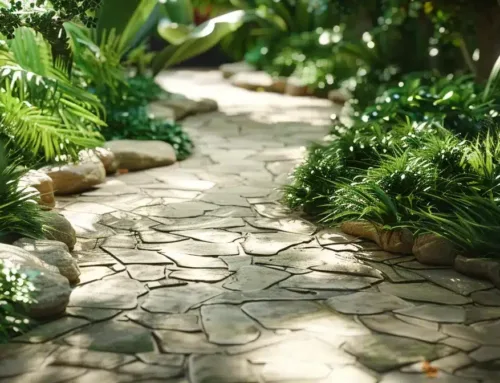Selecting the Ideal Materials for Your Outdoor Walkway
Stepping out onto a new walkway can transform the journey from your driveway to your doorstep into an experience that delights the senses.
As a seasoned provider of landscape services, I understand the importance of selecting materials that not only complement the walls and foliage of your garden but also work in harmony with the soil and climate of your area.
Choice is abundant, whether you seek the timeless appeal of natural stone to match that elegant lighting design or require the robustness of concrete to withstand heavy foot traffic.
In this article, we’ll guide you through the maze of options to find the materials that will make your outdoor walkway both stunning and enduring.
Keep reading to unearth the path that’s perfect for you.
Assessing Your Outdoor Space for Material Suitability
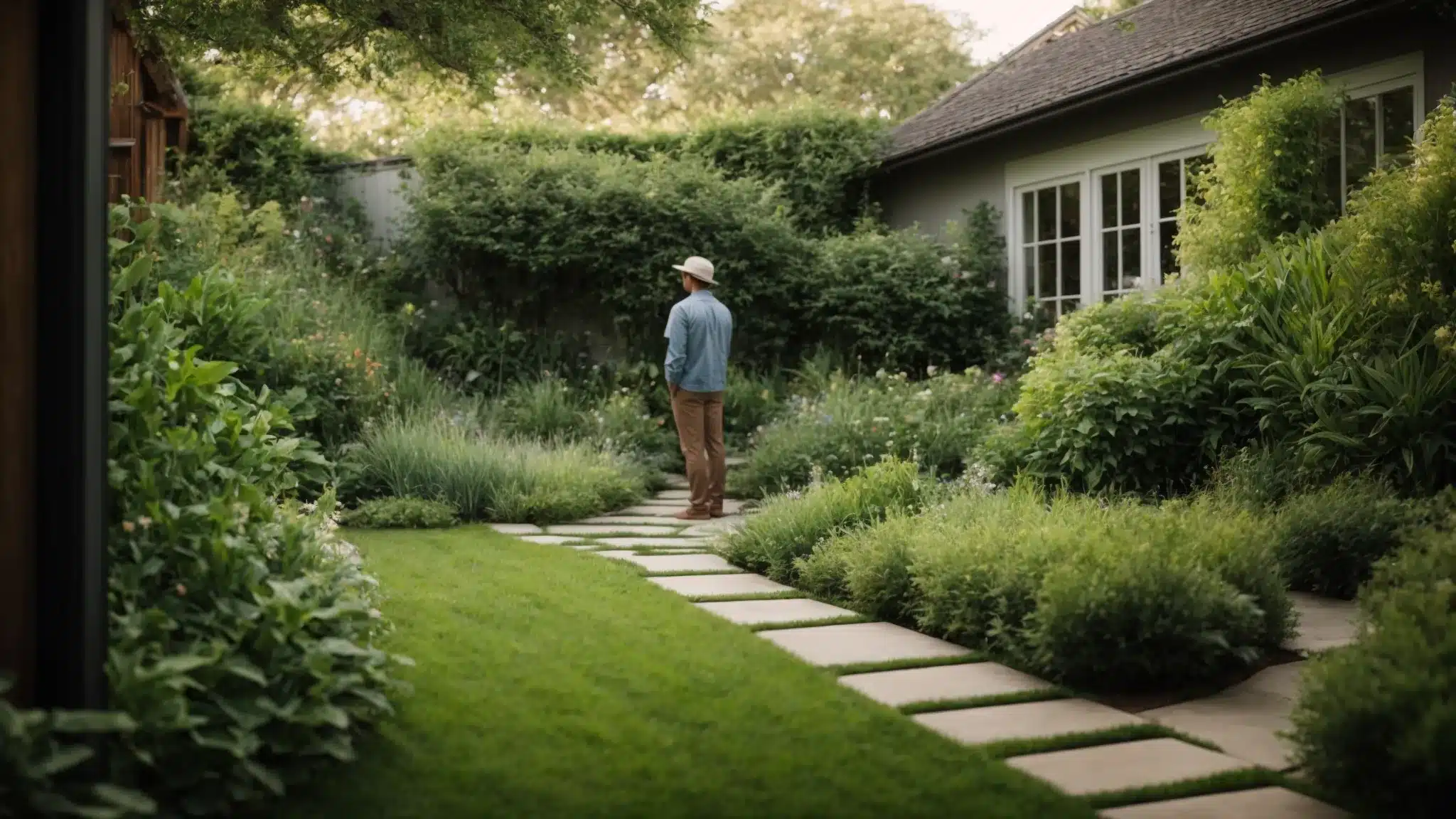
Hey there!
I’m thrilled you’re joining me on this journey of picking just the perfect materials for your brand-new outdoor walkway.
Before we jump into the nitty-gritty of choosing between chic bluestone or an elegant herringbone pattern, it’s key to take a closer look at your unique space.
Take it from someone who’s walked the walk, assessing your garden’s characteristics could save your family from future headaches.
Let me share some golden nugget tips to ensure your new path not only looks great but stands the test of time.
We’ll explore how your local climate and weather patterns can influence material durability, dig a little into understanding your soil type—which is crucial, I promise—and I’ll help you weigh out how the existing greenery and aesthetics of your landscape services should sway your choice.
Plus, we can’t forget about foot traffic!
Whether it’s a quiet path for reflection or a bustling track to your outdoor kitchen, getting these details right from the start is your pathway to success.
Enjoy peace of mind as we navigate these factors together to uncover solutions tailored just for you.
Evaluating the Climate and Weather Conditions
Understanding the whims of your local climate goes a long way when deciding on materials for your walkway. The freeze-and-thaw cycles can turn what was initially a solid concrete path into a cracked surface that could make shoveling a challenge or impede smooth wheelchair access. So, it’s not just aesthetics we’re after; it’s durability in the face of snow, ice, and even the beating sun. An installation that takes these elements into account will save you hassle down the line and make sure your outdoor spaces remain accessible and safe no matter the weather.
Understanding Your Soil Type
Peeking beneath the surface to get a handle on your soil type isn’t just for farming—it’s vital for laying down a solid path, whether you’re dreaming of a rustic wood bordered trail or a sleek brick promenade. Choosing pavers that marry well with the local soil can prevent your sidewalk from shifting and losing its alluring color. Plus, understanding what’s underfoot ensures your walkway materials are set up for success, saving you from sinking feelings and sagging corners in the years to come.
Considering the Surrounding Landscape
As we contemplate the way your elegant tile or sandy path is going to weave its way through the flora and fauna of your front yard, it’s critical to think about how it’ll integrate with the existing scenery. We’re aiming for a seamless union where your walkway not only serves as a practical route for pedestrian traffic but also as a harmonious extension of your home’s natural charm. Taking this holistic approach ensures your outdoor enhancements amplify the beauty of your space without competing with it.
Estimating the Foot Traffic
Now, let’s chew over the foot traffic aspect: considering each inch of your path will be trodden by guests, pets, or maybe even the odd bicycle tire, it’s essential to select a material that not only complements your landscape but can also take a pounding. Think sustainability; a well-trodden path shouldn’t lead to unwanted curb appeal by quickly deteriorating. For steeper slopes, materials that provide grip are key, and you might want to steer clear of anything too slick or plastic-y that could become a slip-and-slide in wet weather.
Exploring Concrete Options for Durability

Stepping into the realm of concrete, we delve into a material both versatile and steadfast, making it an exceptional choice for crafting durable pathways in our outdoor spaces.
From the classic elegance of smooth finishes to the textured artistry of stamped variations, concrete presents us with options aplenty.
But the decision-making doesn’t pause there; for areas bustling with activity, the strength offered by concrete pavers is unparalleled.
As we chart the course of your walkway, let’s consider the resilience needed to combat the elements and traffic.
Exploring the ins and outs of maintenance will guide us to understand how these concrete choices contribute to the longevity of your path, keeping in mind the charm of your surroundings and the importance of integrating with existing mulch beds and water features.
Ready to break ground?
Let’s navigate these concrete solutions to ensure your pathways stand as timeless tributes to both function and beauty.
Comparing Stamped vs. Smooth Concrete
Deciding between stamped or smooth concrete for your pathway is like carefully selecting a piece of art that doubles as a billboard, advertising your home’s aesthetic to every visitor. Stamped concrete, with its rich textures and patterns, can mimic the appearance of natural stone or brick, elevating your garden and complementing the lush shrubs with flair. On the other side, the classic look of smooth concrete offers a clean, uncluttered visual leading to your patio, providing excellent drainage and a solid base that resists the shifting attributed to crushed stone.
The Benefits of Concrete for High-Traffic Areas
When considering high-traffic areas, especially in a setting where beauty is as crucial as functionality, concrete is a customer favorite. Holding up brilliantly under the comings and goings of daily life, it ensures that your stairs remain safe and that stepping stones amidst your favorite plant collections continue to provide a stable, welcoming path through the seasons. This durability empowers homeowners to enjoy their outdoor spaces without constant concern for wear and tear.
Maintenance and Longevity of Concrete Walkways
Maintaining the concrete that guides you to your cozy fire pit or lines the pathway to your garden isn’t just about keeping up appearances; it’s crucial for longevity. Regular sealing wards off cracks from snow and freezing temperatures, while smart design considerations like borders or inlays can discourage weeds from encroaching on your walkway. Ensuring that your pathway remains clear of debris and vegetation not only enhances its beauty but also contributes to safer, longer-lasting enjoyment.
- Regularly apply sealant to prevent weather-related damage, particularly from snow.
- Incorporate design elements like borders to simplify weed control and protect pathway edges.
- Keep the pathway free from organic debris to maintain its integrity and appearance.
The Charm of Natural Stone Walkways
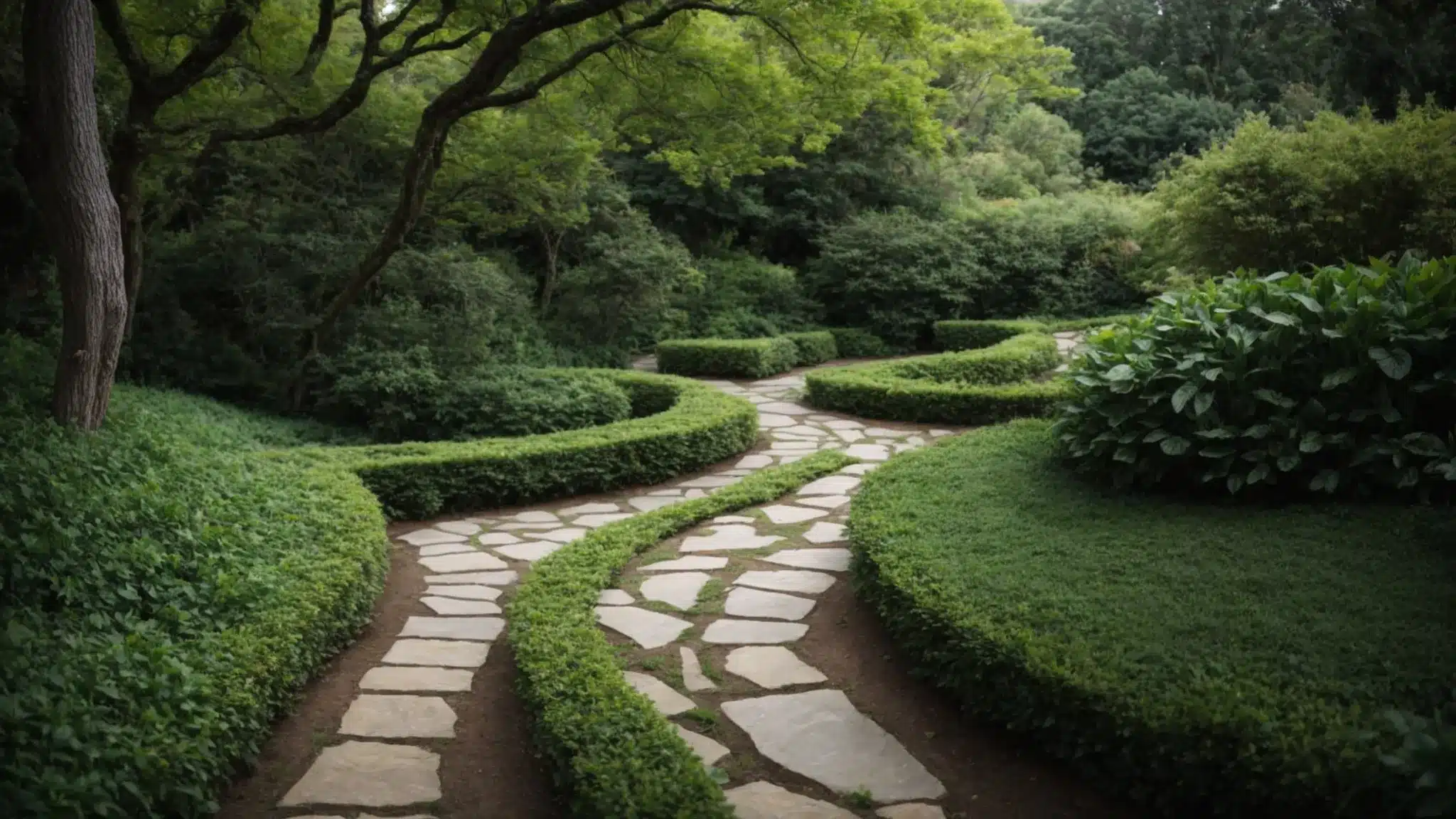
Turning our attention to the enduring beauty of natural stone, we open a chapter rich with rustic charm and robust endurance for our outdoor pathways.
Envision the rugged grandeur of Flagstone, the tranquil sophistication of Limestone, and the unique, earthy allure of Slate as prime candidates for our garden stroll.
Each stone brings a slice of nature’s artistry right to our doorstep, blending seamlessly with the ancient trees and lush foliage that frame our homes.
We’re not just carving a trail; we’re laying down a legacy of natural elegance that not only weathers the storm but also dances with the ice and sun.
As a DIY enthusiast, you’ll be glad to know that we’ll delve into tried-and-true installation techniques that ensure stability and visual harmony with the surrounding garden.
And to keep our stone path looking its best, we’ll explore caring practices that preserve its charm and make maintenance a breeze rather than a burden.
So let’s grab our tools and our gardening gloves – a journey through the virtues of stone awaits!
Types of Stone: Flagstone, Limestone, and Slate
As we consider the various types of stone suitable for our outdoor spaces, flagstone emerges as a distinct favorite, known for its natural aesthetic and ability to resist heat, ensuring comfortable passage even on sunny days. Limestone, with its refined textures and light color palette, reflects sunshine, keeping the pathway cooler. A touch of yesteryear’s cobblestone charm can be brought to life with slate, offering a rugged durability that fends off most wear and tear issues with simplistic grace.
Stone Walkway Installation Techniques
As we lay each meticulously chosen stone, painting the canvas of your garden walkway with touches of thyme nestled between the slabs adds a fragrant, natural allure to your space. Integrating such thoughtful ideas into the installation process doesn’t just secure the stones; it weaves personality and life into the walkway, crafting an ambience that makes every step along your garden path a sensory delight.
Care and Maintenance of Stone Paths
Maintaining the elegance of your stone walkway is a little like caring for the pea plants in your garden – it requires attention and the right tools. Being proactive with your maintenance schedule preserves the path’s charm, ideally preventing any weeds from peeking through and disrupting the harmony between your porch and the vibrant greenery of your backyard oasis. Just remember, a sturdy paver base is the roof to your walkway’s longevity, and with a gentle sweep of your favorite broom, you’ll keep those natural stone pieces looking as timeless as ever.
The Versatility of Brick as a Walkway Material
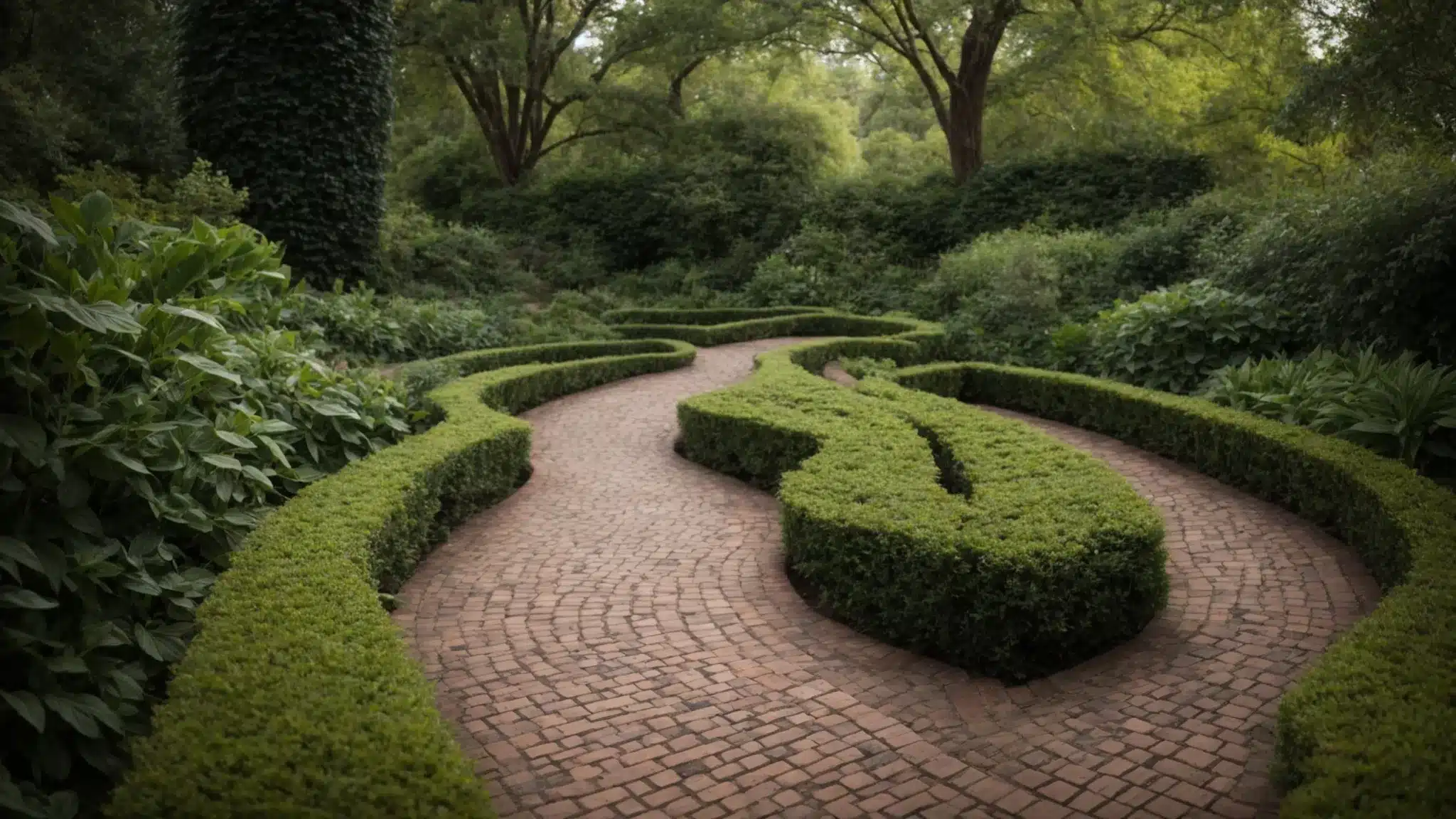
Embarking on a yard transformation often leads me down the delightful road of home improvement, where the simple addition of a brick walkway can anchor a garden’s aesthetic firmly into the elegance you seek.
Embracing a robust selection from the varied brick pallet at our disposal, we’re privy to an array of patterns that can stretch the visual length of our paths or infuse them with playful whimsy.
As your friendly guide, I’ll unveil the secrets behind balancing the raw beauty of brick with the uncompromising strength required to endure season after season.
Stick with me for some savvy tips on maintaining your brick walkways, ensuring they remain a cornerstone of your home’s charm for years to come.
Choosing Between Brick Patterns
When it feels like you’re standing at a crossroads in a home improvement store, deciding between the countless brick patterns, don’t fret! As a landscape designer, I’ve seen how the right pattern can act as the canvas to your outdoor art, shaping the vibe of your garden. For a classic, timeless look, the herringback pattern might be your rock, while a basket weave design introduces an understated elegance that pairs well with creeping moss and softens the transition between gravel and greenery. It’s about creating flooring that complements your outdoor living space and weathers the footsteps of time with grace.
, flowering plants
Balancing Aesthetics and Durability
In the alchemy of outdoor design, blending aesthetics with durability is like composing the perfect harmony, where your brick walkway crosses a backdrop of natural splendor: think a pebble trim highlighting the mosaic of colors in your chosen bricks, contrasting with the softness of the surrounding hardscape. Such decisions in landscaping can echo your personal style, creating not just a pathway, but a lasting impression that withstands both weather and wear while beckoning visitors closer with its inviting charm.
- Infuse natural beauty with a pebble border to complement the brickwork.
- Choose color-rich bricks that form a visually striking mosaic against the greens of your garden.
- Opt for materials in your hardscape that are as robust as they are enchanting to ensure longevity.
- Marry form with function by picking landscaping elements that endure and inspire.
Tips for Brick Walkway Maintenance
Keeping a brick paver walkway in tip-top shape means more than just a quick sweep; it’s about maintaining the integrity of the lawn edges and ensuring perennials aren’t creeping over and obscaring the beauty of your design. Occasionally, you might find yourself leveling a brick here or there to keep that dimension of depth consistent and checking that any lumber used for edging remains rot-free and firmly in place. It’s these little acts of care that keep a paver walkway looking as though it were laid down yesterday, even as seasons change.
Eco-Friendly Options: Grass and Gravel Pathways
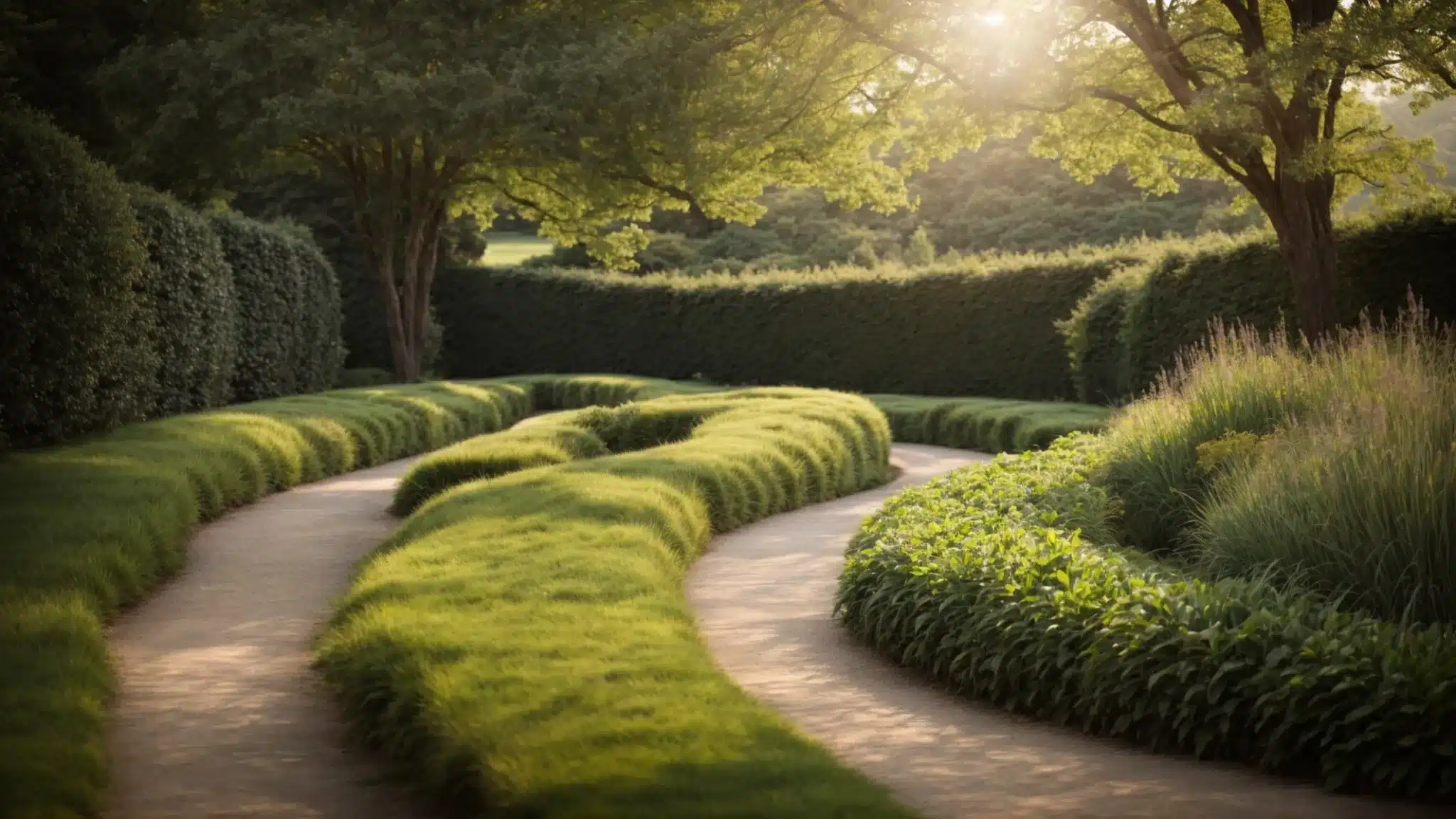
Stepping away from traditional paths, envision your walkway not just as a means to traverse your yard, but as an evergreen tapestry that enhances your landscape design.
Injecting a bit of greenery with grass pavers can create a living path that integrates seamlessly into the lawn, marrying aesthetics with ecology.
On the flip side, designing a permeable gravel path can offer the stability of more conventional materials while still being kind to the planet.
Utilizing these eco-friendly walkway materials isn’t merely a design choice; it’s an advertisement for sustainability, subtly showcasing environmental awareness through your choice of outdoor furniture and pathways.
Let’s explore the verdant possibilities and the inherent benefits of embracing these green solutions for our garden’s journey.
Creating a Green Walkway With Grass Pavers
Imagine stepping across a lawn, where each footfall is cushioned by lush grass, yet the stability underfoot is uncompromised. That’s the magic of grass pavers in action; they offer an eco-conscious pathway solution that blends beautifully with the environment, inviting a serene walk through nature while supporting green growth.:
- Grass pavers provide the dual function of promoting natural greenery while ensuring a durable walkway.
- Choosing this eco-friendly option means investing in a living landscape feature that harmonizes with your outdoor space.
- Maintaining grass between pavers is as simple as a regular lawn care routine, keeping your walkway vibrant and earth-friendly.
Designing a Permeable Gravel Path
Embarking on the creation of a permeable gravel path is to weave together practicality with environmental reverence. Such a path not only invites a natural texture and understated beauty to your outdoor space but also serves a hidden function – it allows rainwater to percolate back into the earth. The result is a walkway that complements your garden’s aesthetics while supporting sustainable land practices, a true testament to thoughtful landscaping.
Benefits of Eco-Friendly Walkway Materials
The decision to opt for eco-friendly walkway materials comes with a wealth of benefits: by choosing options like grass and gravel, you’re not just creating a walkway—you’re contributing to a sustainable environment. These materials encourage natural water drainage and soil replenishment, fostering a healthier ecosystem right in your own backyard. Embracing eco-friendly solutions allows your garden to thrive, reduces runoff, and minimizes your carbon footprint, all while setting a splendid natural scene for every step you take outdoors.
- Encourages natural water drainage and reduces runoff
- Contributes to soil replenishment and a healthier ecosystem
- Minimizes environmental impact and carbon footprint
- Enhances garden vitality and aesthetic appeal
Incorporating Pavers for a Personalized Touch
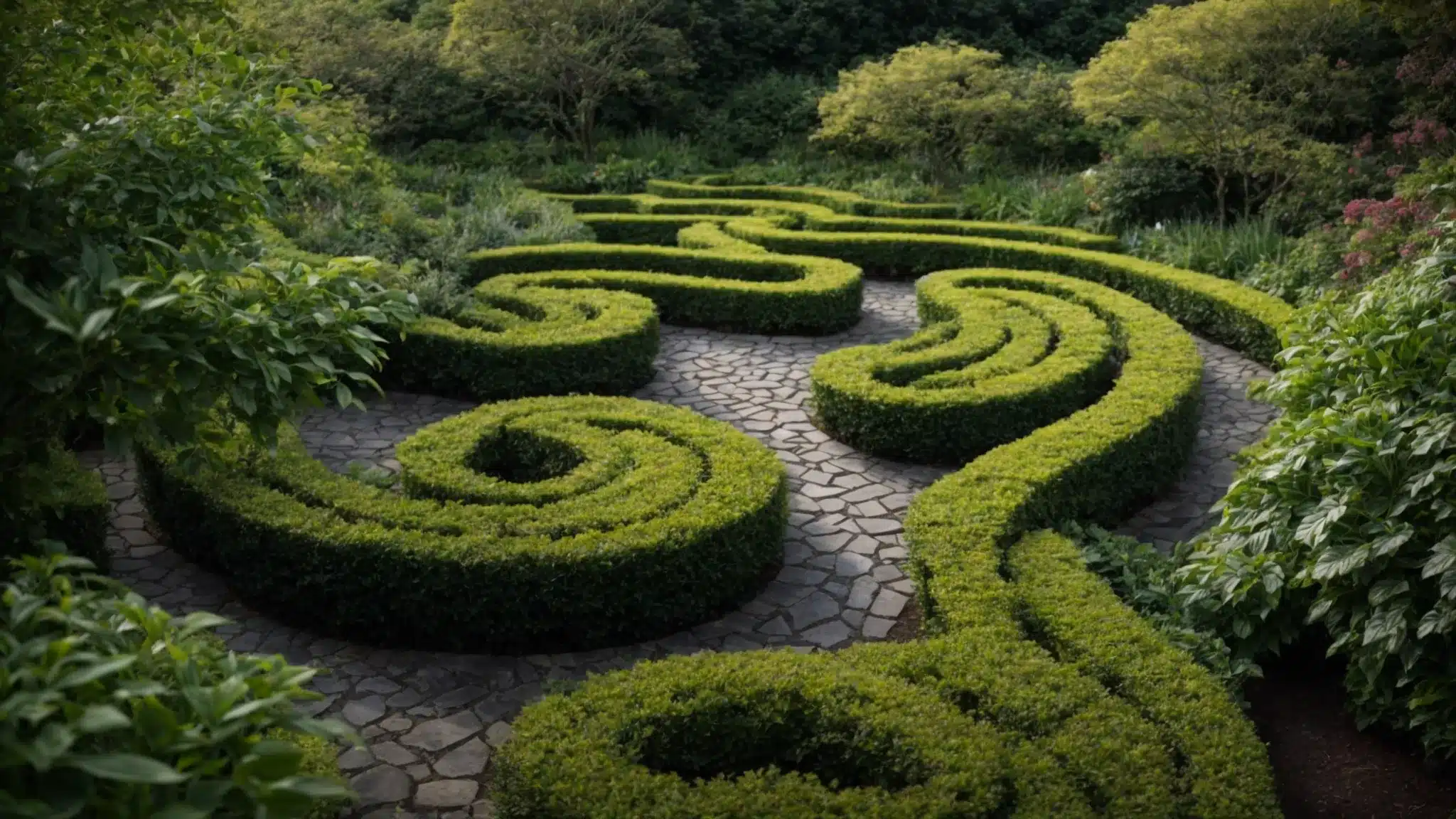
So, you’ve decided to enhance the journey through your outdoor oasis with a walkway, and now it’s time to get creative with your paver selection.
It’s not just about picking the prettiest tiles; we’re searching for the soulmate to your landscape, a material that resonates with your vision, be it the rich textures of natural stone or the versatile charm of concrete.
I’m excited to guide you through the nuances of each choice, revealing a world of design ideas to craft a path as unique as your garden.
And let’s not overlook the foundation of our path—ensuring the stability and longevity of your walkway is paramount, ensuring that this personalized touch to your outdoor space endures season after season.
Selecting Pavers: Concrete vs. Stone
When it’s time to personalize your garden path, the debate often boils down to choosing between concrete and stone pavers. With concrete, I’ve admired its versatility and the endless color and shape options, perfect for creating a modern look or a whimsical pattern. In contrast, stone pavers bring a timeless elegance to the table, each piece boasting a unique texture and hue that connects your walkway to the natural world around it.
Design Ideas for Unique Paver Layouts
Stepping out of the box with paver layouts means embracing the unexpected; it’s about crafting a path that plays with curves, challenges straight lines, and becomes a visual journey. If you’re itching to showcase creativity, try interspersing different paver shapes to lead the eye through vibrant flowerbeds or weave a tapestry of color with variegated stones that echo the sunset hues of your garden. The charm lies in creating a path that tells a story, one where each turn and tessellation is a chapter in the narrative of your outdoor retreat.
Ensuring Stability and Longevity of Paver Walkways
Choosing the right base and installation approach for your paver walkway is like laying the groundwork for a house – it’s what ensures your pathway stays level, resists the unpredictable Midwest freeze-thaw cycles, and gracefully weathers the footsteps of countless seasons. A properly prepared foundation, with a compacted sub-base and bedding sand, is your first defense against shifting and settling pavers, ensuring your outdoor walkway remains as steadfast and inviting as the day it was laid.
Mixing Materials for Unique Walkway Designs
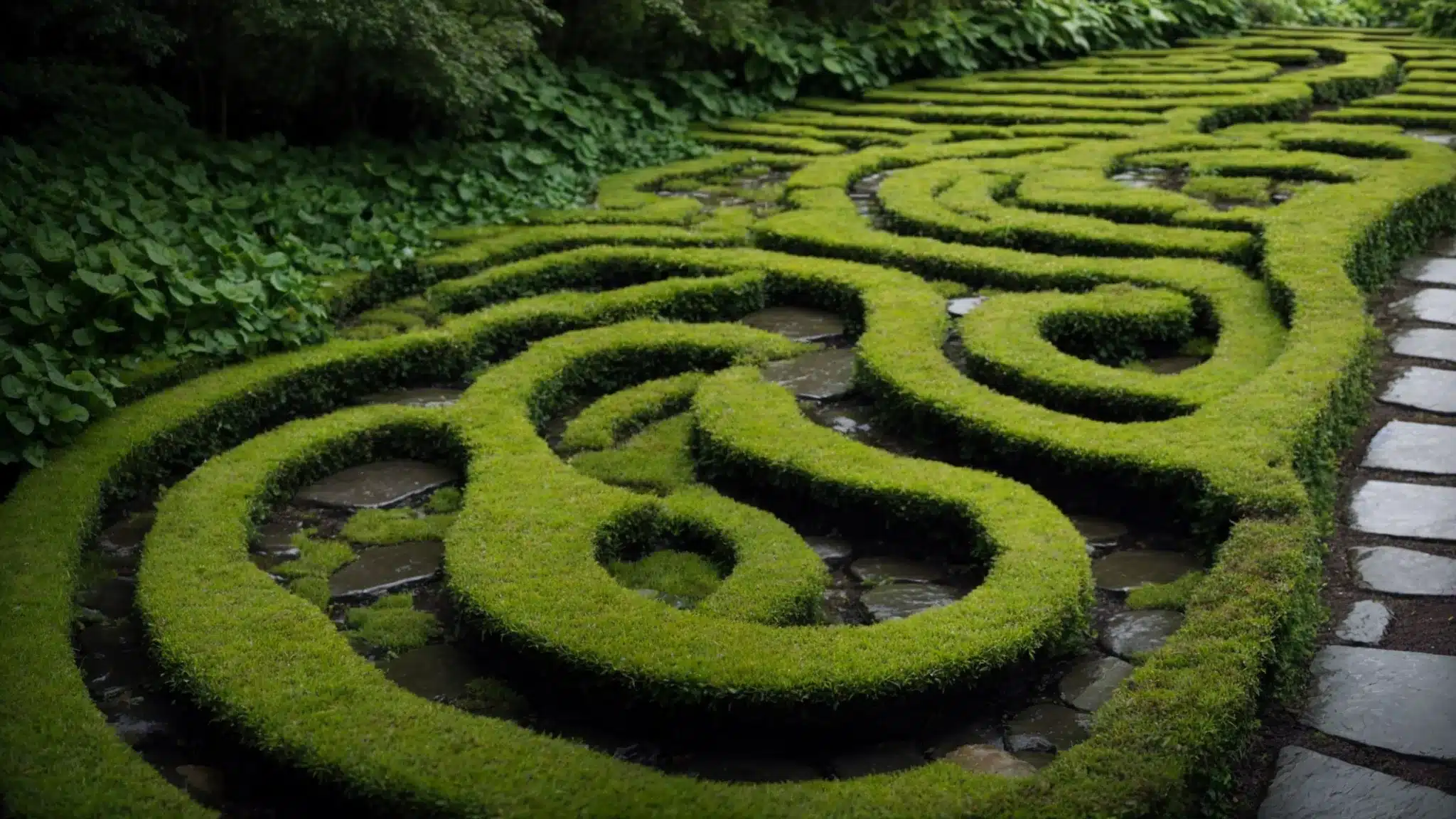
Embarking on the design of your outdoor walkway is like painting on a blank canvas; it’s an opportunity to express your unique style and embrace the full potential of your landscape.
By mixing various walkway materials, you open up a world of textural and visual delights that can define the character of your space.
Picture smooth pavers bordered by pebbles, or slate stepping stones hugged by lush ground cover — these are the combinations that invite both intrigue and fluidity into your garden path.
In planning your mixed material walkway, it’s key to consider not just the visual appeal but also the functional interplay between the materials.
And let’s not forget the vital role of managing drainage; choosing complementary materials that work together to efficiently channel water away will ensure your path remains as practical as it is picturesque.
Combinations That Work Well Together
In the tapestry of landscape design, finding harmonious material combinations can transform your garden paths into captivating works of art. For a touch of elegance, pairing flagstone with a border of contrasting river rocks defines edges with organic beauty, and for practical charm, use durable brick accented by lush ground cover like creeping thyme to soften the borders and add a sensory experience with every step:
- Flagstone with river rock borders for a striking natural contrast.
- Brick walkways with creeping thyme for a durable yet soft appearance.
- Gravel paths with solid stepping stones, ensuring stability and visual variety.
- Smooth concrete slabs with patches of ground cover between sections for eco-friendly permeability.
Planning Your Mixed Material Walkway
Embarking on the journey of crafting a mixed material walkway calls for a blend of imagination and pragmatism, where each chosen element not only complements the others in texture and hue but also performs impeccably underfoot. As we map out the design, we prioritize cohesion and functionality, ensuring that every step along this uniquely crafted pathway enhances your outdoor experience, marrying aesthetics with the enduring quality you deserve in your personal slice of nature.
Handling Drainage With Different Materials
Dealing with drainage is as much of an art as it is a science, especially when melding various materials in your walkway design. I heartily encourage considering how each choice, from permeable gravels that allow water to seep through to solid pavers that channel runoff to appropriate areas, will interact with rainfall and irrigation in your garden. Ensuring a thoughtful combination not only preserves the form and function of your path but also protects the surrounding landscape from water damage, crafting a walkway that’s as responsible as it is beautiful.
Utilizing Wood for Natural and Rustic Walkways
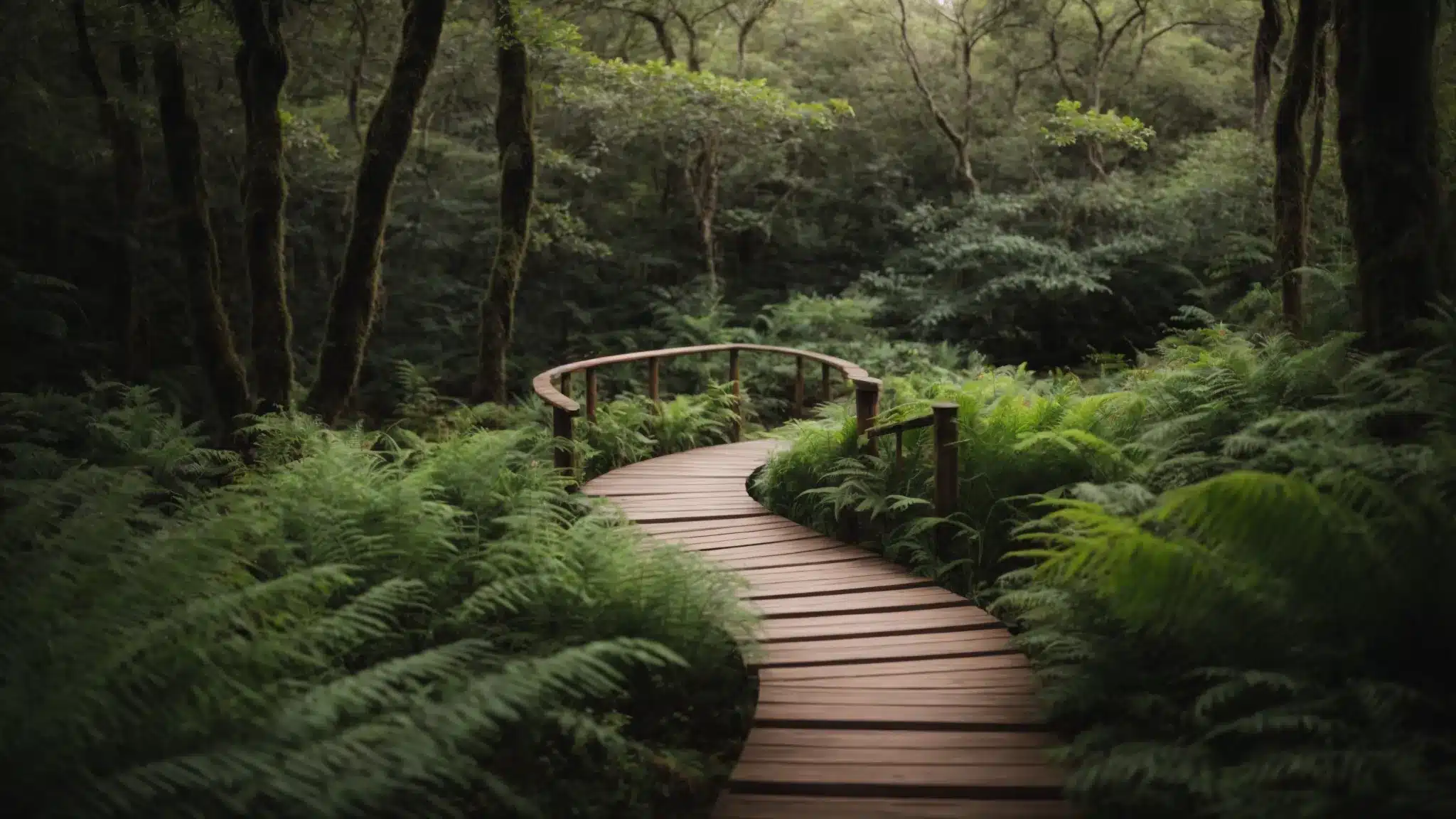
Delving into the world of wood conjures images of serene forest trails and the homely warmth that only natural timber can provide.
As we venture into selecting wood for our outdoor walkways, remember that not all timber is created equal.
We’ll angle our focus towards those varieties that hold up best against the elements, keeping their integrity when faced with moisture, insects, and temperature swings.
From laying down the planks to ensuring their longevity, our approach will blend practical construction methods with the character of natural wood to establish safe and stable walkways.
We’ll also touch on essential upkeep to safeguard your wooden path from the ever-changing outdoor conditions, ensuring it remains a cherished feature in your landscape through every season.
Best Types of Wood for Outdoor Use
When bringing the unmatched warmth and organic appeal of a wooden walkway to your garden, choosing the right type of wood is crucial: you’ll want something that not only matches the aesthetic you’re going for but also stands strong against the whims of nature. Cedar, with its natural resistance to decay, and dense woods like Ipe and Teak, known for their longevity and ability to fend off pests, are standout choices for crafting a durable and enchanting path through your outdoor sanctuary.
- Cedar: Naturally rot-resistant and exuding a pleasant aroma, perfect for blending with your garden’s scents.
- Ipe: Known for its incredible density and strength, making it an ideal candidate for high-traffic areas.
- Teak: Boasts weather-resistant properties and a classic aesthetic that ages beautifully over time.
Constructing Safe and Durable Wood Walkways
As we roll up our sleeves to build a wooden walkway, safety and durability are top of mind. Ensuring that each plank is securely anchored and that the structure can withstand both the joyful rush of a family barbecue and the solitary steps of a dewy morning requires expertise, from choosing rot-resistant wood to the precision of the build itself. It’s about creating a pathway that invites exploration and stands as a testament to the timeless allure of wood—in all its natural, rustic glory—with every footstep echoing a job well done.
Preserving Your Wood Path Through the Seasons
Ensuring that the charming wood path winding through your garden is resilient enough to embrace every season means embracing a routine that keeps the wood nourished and protected. From applying a fresh coat of stain to ward off the harsh sunrays or snowmelt chemicals to scheduling inspections for potential wear points, I always emphasize proactive care. It’s these loving touches that keep your wooden walkway primed for longevity, serving as an inviting thoroughfare through your blooming oasis year after year.
Innovation With Resin-Bound Walkways
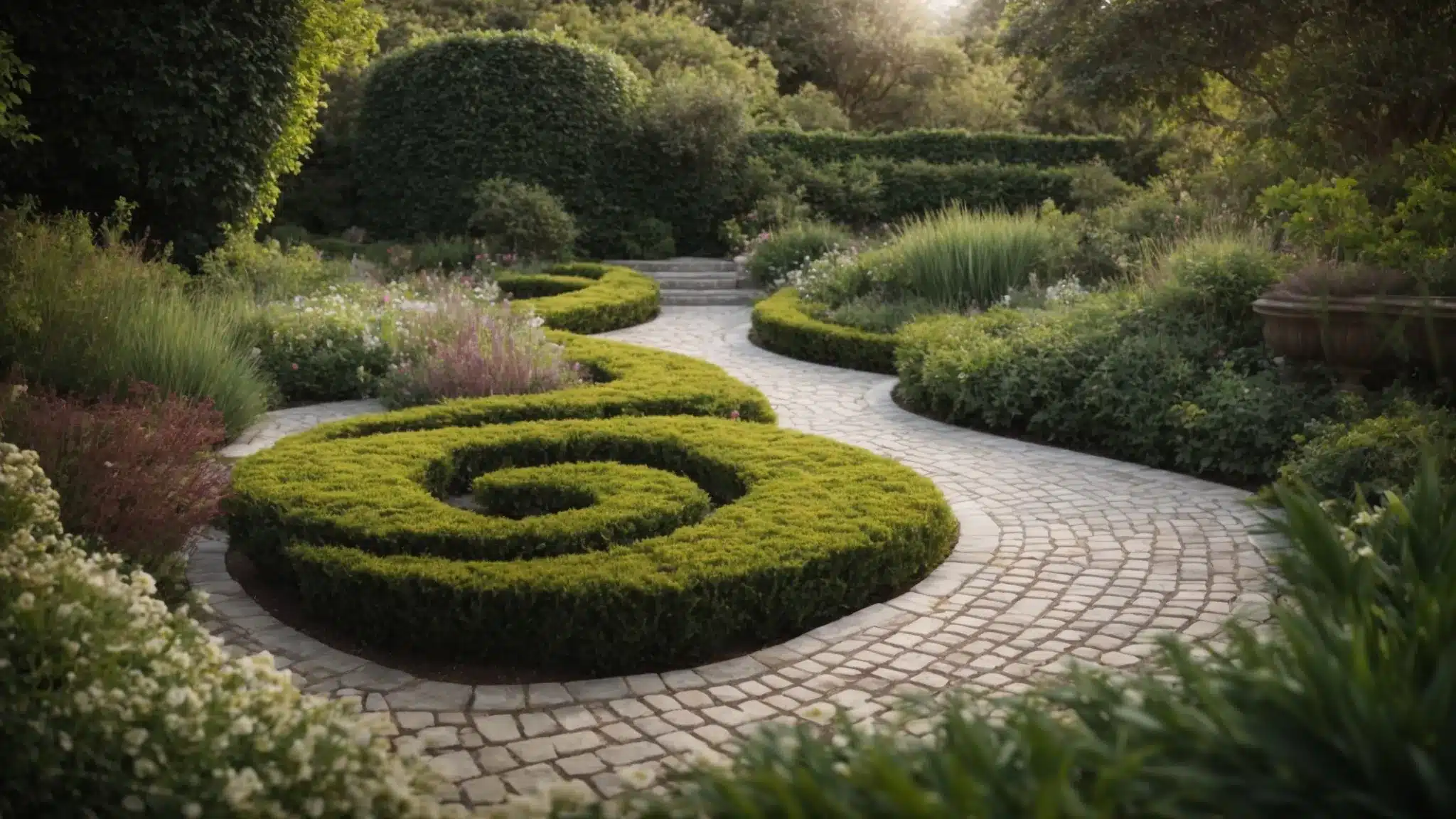
Now, let’s turn our attention to the innovative world of resin-bound walkways, a cutting-edge option that merges style with performance.
This unique material offers numerous advantages, including permeability and a virtually maintenance-free finish that homeowners love.
Each step taken on a resin-bound surface is one that combines practicality with curb appeal, offering an eye-catching finish that’s also known for its durability.
As we delve into this material, we’ll explore not just the attractive qualities it presents visually, but also the functionality that makes it such a wise choice for today’s landscapes.
And of course, I’ll guide you through the surprisingly straightforward care requirements, ensuring your pathway remains pristine with minimal effort.
So, if you’re ready to redefine the elegance and efficiency of your outdoor living space, resin-bound pathways provide a solution that’s as enduring as it is enticing.
The Advantages of Resin-Bound Surfaces
Diving into the world of resin-bound surfaces is like discovering a secret garden of possibilities; it’s a material that marries sleek aesthetics with incredible practicality. Not only does it boast a virtually maintenance-free finish, but its permeable nature also makes it a standout for eco-friendly, drainage-conscious design. For homeowners looking to infuse their outdoor space with modern flair and fuss-free upkeep, resin-bound pathways are a dream come true, offering a durable surface that looks sophisticated year after year.
Crafting an Attractive Yet Functional Walkway
When it comes to crafting an attractive yet functional walkway, resin-bound surfaces offer an ingenious balance between style and practicality. I take pride in selecting materials that not only draw the eye with their striking finishes but also provide a strong, long-lasting function that effortlessly supports the comings and goings of daily outdoor activity. It’s fulfilling to create pathways that stand as a testament to thoughtful design—those that beautifully fuse the homeowner’s vision with the innate character of their landscape.
The Care Requirements for Resin Walkways
Caring for your resin-bound walkway is refreshingly straightforward, reflecting the ease that defines this material’s entire ethos: maintenance involves occasional sweeping to keep the surface free from debris and a gentle clean with a hose or light pressure wash to refresh its appearance. The inherent durability and permeability of resin mean that issues like standing water or troublesome weeds are a distant concern, allowing your path to maintain its charm with minimal intervention.
- Gentle sweeping to remove leaves and organic materials that could decompose on the surface.
- Hosing down periodically or using a pressure washer on a low setting for deeper cleaning.
- Regular visual checks to ensure the surface integrity remains intact and address any repairs swiftly.
Budgeting for Your Walkway Project
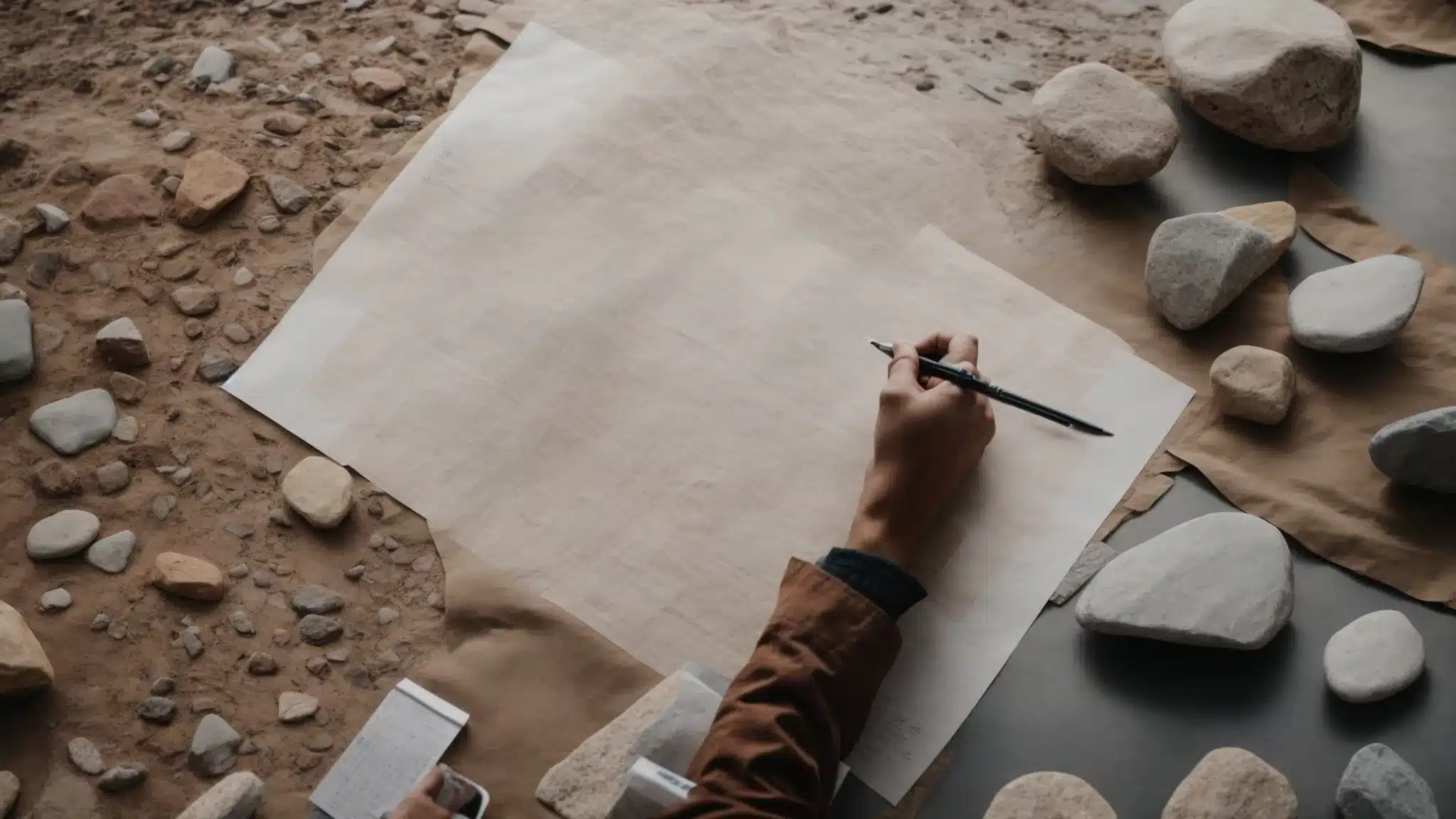
Alright, let’s talk dollars and cents because, undoubtedly, the budget is a significant piece of the walkway puzzle.
In my experience, it’s essential to have a clear picture of the costs involved with different materials as they can vary dramatically – from affordable mulch to premium natural stone.
Knowing where you can afford to indulge a little and where to tighten the purse strings without sacrificing style or quality is key.
And we can’t just look at upfront costs, of course; planning for the long haul means considering the longevity and upkeep of your chosen materials.
Setting aside a part of the budget for the future care of your walkway ensures that you won’t be caught off guard by maintenance expenses down the road.
So, let’s get our calculators out and lay the groundwork for a financial plan that aligns with our landscaping dreams.
Calculating the Cost of Different Materials
Embarking on designing your walkway involves sifting through material options while keeping a keen eye on your budget. Whether you’re gravitating towards the rustic charm of wood, the earthy appeal of natural stone, or the clean lines of poured concrete, understand that the pricing spectrum is as varied as the materials themselves. I’ll help you navigate this financial landscape, ensuring we find that sweet spot where cost-effectiveness meets the aesthetic and functional demands of your envisioned path.
Where to Splurge vs. Save
When it comes to your outdoor walkway, knowing when to splurge and when to save can make all the draw the line between a standout feature and a budget savvy move. I always advise splurging on durability for high-traffic areas – investing in premium materials here means less repair and replacement in the long run. On the flip side, save by choosing less expensive yet attractive options for less frequented spots, applying your creativity with affordable edging or accents that make an impact without breaking the bank.
Financial Planning for Maintenance and Upkeep
Deciding on the right materials for your outdoor path isn’t simply a matter of selecting the prettiest or the most durable options—it’s also a question of considering the long-term care each material requires: Will the initial lower cost of certain options lead to higher maintenance expenses down the road? Being clear about the upkeep involved ensures your walkway project is cost-effective for years to come, allowing you to budget not just for installation, but also for the care and maintenance that will keep your pathway looking fresh as time goes by.
Conclusion
Choosing the ideal materials for your outdoor walkway is vital for harmonizing with your home’s natural surroundings and optimizing longevity.
Consideration of local climate, foot traffic, and soil composition influences the durability and maintenance demands of your path.
Investing in suitable materials and considering eco-friendly options can enhance outdoor aesthetics while promoting sustainability.
By carefully planning and selecting materials that marry form with function, you can create an inviting and enduring walkway that brings life to your landscape.


